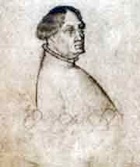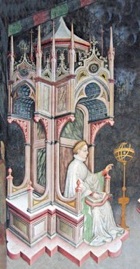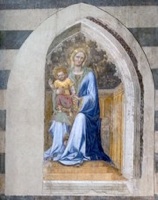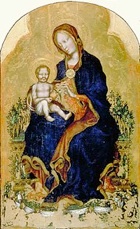
Gentile da Fabriano probably moved to Venice in 1402, following the death of Gian Galeazzo Visconti (when Chiavello Chiavelli also took service with Venice). He established a workshop in the parish of Santa Sofia. He is first documented there in 1408, when he enrolled in the Scuola di San Cristoforo dei Mercanti, and seems to have remained in the city until 1414. His work from this period included a now-lost fresco in the Sala del Maggior Consiglio in Palazzo Ducale.
Gentile da Fabriano spent the following decade in the Marches, before moving to Florence. He enrolled in the Arte dei Medici e degli Speziali there in 1422, and stayed in the city for the next three years. Important works from this period include:
-
✴the Palla Strozzi (1423), which is now in the Uffizi Gallery, Florence; and
-
✴the Quaratesi Polyptych (1425), the central panel of which is now in the National Gallery, London.
Gentile da Fabriano spent two month of 1425 in Orvieto, before moving to Rome to work for Pope Martin V. He died in Rome in 1427.
Foligno
Frescoes of Palazzo trinci (1411-12)

The attribution of these frescoes was unclear until 2000, when a book of handwritten notes was found in a private archive in Foligno in which it seems that the scholar Lodovico Coltellini had documented some of the frescoes of Palazzo Trinci in 1780. In particular, he had apparently seen two receipts in a chest in the “camera delle udienze” of the papal governor for payments that Ugolino III Trinci had made in August 1411 and in January 1412 to Gentile da Fabriano for work on three rooms on the piano nobile of the palace. This suggested that Ugolino III Trinci had been commissioned the frescoes soon after the palace was completed: an inscription gives the construction period as 1389-1407, although other documents suggest that the work actually continued until 1411.
The status of the material attributed to Lodovico Coltellini is equivocal, and some scholars doubt that Gentile da Fabriano was associated with the work. However, Ugolino Trinci had family ties with Chiavello Chiavelli, and this could well explain such a commission. Many scholars reject the attribution on stylistic grounds, arguing that, if Gentile da Fabriano were indeed involved, the frescoes must have been largely executed by his workshop. The first of the newly-discovered documents included the names of some of his collaborators:
-
✴Jacobo da Venezia, possibly the young Jacopo Bellini;
-
✴Francesco di Giambono da Bologna, who was described as resident in Foligno;
-
✴Battista di Domenico da Padova, who was documented again in Foligno in 1417 and 1426; and
-
✴Paolo Nocchi, the only locally-born artist mentioned.
It seems likely that other artists were also involved in the project.
The three rooms mentioned in the documents were:
-
✴the loggia;
-
✴the Sala delle Rose (also called the Sala delle Stelle or delle Arti e dei Pianeti); and
-
✴the Sala dei Giganti (also called the Sala degli Imperatori).
Most of the frescoes that were discovered under plaster in 1918-9 corridor from Palazzo Trinci to the Duomo are also usually attributed to this group of artists.
Orvieto
Madonna and Child enthroned (1425)


Before restoration of 1984-9 After restoration of 1984-9
Gentile da Fabriano executed this fresco on the left wall of the Duomo. This was one of the first works commissioned by the Opera del Duomo after the renewal of its autonomy and the publication of its first formal statutes in 1421. Gentile arrived in Orvieto in August 1425 and was paid for the completed work two months later. The Opera del Duomo insisted that the Alberici family remove coats of arms that they had commissioned below the fresco, in order to underline their direct control of the decoration of the Duomo and their responsibility for the commissioning of this important component of it.
The image was highly venerated, and it was probably for this reason that it was one of the few frescoes in the church that was not covered in the 16th century remodelling of the interior. Instead, it was enclosed in a stucco tabernacle that was incorporated into the new unified decorative scheme in 1568. A figure of St Catherine was added to the right, in order to bring the fresco and its new tabernacle into the centre of its bay. The tabernacle was removed in the late 19th century and replaced by a fictive mosaic surround (illustrated above). The figure of St Catherine was removed in the restoration of 1984-9, and the original figure of a transparent angel was found underneath.
As restored, the fresco depicts the Madonna and Child enthroned. The Child is trying to clamber off the Madonna's lap, His arm raised in blessing. Much of the original modelling of the figures (particularly of the Madonna’s robes) has been lost. The work is nevertheless of exceptional quality.
Perugia
Followers of Gentile da Fabriano in Perugia included Pellegrini di Giovanni and Lello da Velletri.
Madonna and Child (ca. 1410)

There is no surviving documentation that relates to the panel until 1861, when it was in the chapel of the Novitiate, inside the convent. It entered the Galleria Nazionale in 1863. Maria Rita Silvestrelli (referenced below) has suggested that it was originally in the Cappella di San Giacomo (now the sacristy) and that its frame bore the arms of the Graziani family.
The panel, which has been cropped at the sides and cut down at the top, was clearly originally in a trefoil frame. It might originally have been the central panel of a triptych or polyptych, but the fact that Vasari mentioned only this panel suggests that, if so, the work had already been broken up by the 16th century. Nothing is known of any other components, if indeed they did exist.
The form of the original frame suggests that the panel was painted in Venice. Its iconography is emphatically Marian:
-
✴The Virgin is seated on a throne that is covered with vegetation, which was probably conceived as the hortus conclusus (enclosed garden, a symbol of virginity).
-
✴Three pairs of angels are stippled into the golden background: one pair crowns the Virgin while the other four angels present her with lilies (symbols of purity).
-
✴Seven tiny angels (now very damaged) hold a scroll inscribed with the antiphon Regina Coeli (Queen of Heaven).
-
✴Other inscriptions in the Virgin’s halo and along the edge of her cloak add further praise.
-
✴The Virgin presents the Child with a pomegranate (the symbol of the Resurrection).
This was one of the first examples of what is now called International Gothic art to appear in Perugia. The fine workmanship of the golden background was fully revealed by the restoration carried out in 1994.
Read more:
Foligno
A. De Marchi, “Gentile al Servizio di Ugolino Trinci tra 1411 e 1412”, part of his paper “Gentile e la sua Bottega”, in:
A. De Marchi (Ed.), “Gentile da Fabriano: Studi e Ricerche” (2006) Milan, pp 18-31
G. Benazzi and F. Mancini (Eds), “Il Palazzo Trinci di Foligno”, (2001) Perugia contains the following articles that are particularly relevant for the frescoes by Gentile da Fabriano and his workshop in the palace:
C. Galassi, “Un Signore e il suo Palazzo: Iconografia, Cronologia e Committenza dei Cicli Pittorici nelle ‘Case Nuove’ di Ugolino Trinci”, pp 269-97
F. Mancini, “La Loggia delle Virtù: Allegoria di un Governo Illuminato”, pp 303-36
L. Lametti, “Il Manoscritto Intitolato ‘Appunti sopra la Città di Fuligno: Scritti da Lodovico Coltellini, Accademico Fulginio, Parte Nona, 1770-1780’”, pp 427-46
B. Gialluca, “Osservazioni sugli ‘Appunti sopra la Città di Fuligno: Scritti da Lodovico Coltellini, Accademico Fulginio, Parte Nona, 1770-1780’”, pp 447-57
G. Benazzi, “I Cicli Pittorici del Tempo di Ugolino e Corrado Trinci”, pp 459-94
Orvieto
L. Riccetti, “Orvieto”, in:
A. De Marchi (Ed.), “Gentile da Fabriano: Studi e Ricerche” (2006) Milan, pp 135-9
Two articles in the Burlington Magazine, 131 (1989) relate to the restoration of the fresco in Orvieto:
K. Christiansen, “Revising the Renaissance: 'Il Gentile Disvelato'”, pp 539-41; and
L. Riccetti, “'Dolci per Gentile': New Documents for Gentile da Fabriano's 'Maestà' at Orvieto”, pp 541-2
Perugia
A. De Marchi, “Angels Stippled in Gold: the Perugia Madonna” (and following catalogue entry), in:
L. Laureati and L Mochi Onori (Eds), “Gentile Da Fabriano and the Other Renaissance”, (2006) Milan pp 94-9
M. Silvestrelli, “Perugia al Tempo di Gentile: Artisti, Botteghe, Committenti”, in
A. De Marchi (Ed.), “Intorno a Gentile da Fabriano e a Lorenzo Monaco: Nuovi Studi sulla Pittura Tardogotica” (2008) Livorno, pp 169–186
Return to Art in: Foligno Orvieto Perugia.
Return to “Foreign” Painters in Umbria.



